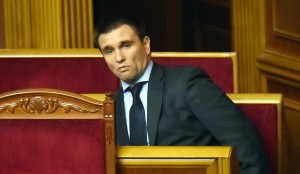BRUSSELS, Belgium — NATO foreign ministers approved fresh support for Ukraine and condemned Russia Tuesday for backing pro-Moscow rebels as the alliance signed off on its new training mission in Afghanistan.
“We strongly condemn Russia’s continued and deliberate destabilization of eastern Ukraine in breach of international law,” said a statement from the NATO ministers and Ukraine’s Foreign Minister Pavlo Klimkin, who took part on a video link.
NATO chief Jens Stoltenberg said they agreed to activate four trust funds which will help pay to upgrade Ukraine’s logistics, cyber warfare, command and control and medical services, and added a fifth to support wounded Ukrainian soldiers.
They also pushed Moscow to honor a wider peace deal agreed in September in the Belarus capital Minsk, saying this was crucial to a political solution to a conflict which has so far cost some 4,300 lives.
“Russia must use its influence over the separatists to ensure they stop their attacks and abide by the ceasefire,” the statement said.
NATO did not comment on local ceasefires with the rebels in Donetsk and Lugansk announced earlier Tuesday but one alliance official stressed that “implementation is key.”
US Secretary of State John Kerry said the West had made repeated efforts to solve the conflict and mend fences with Russia but Moscow had shown no interest.
As a result, the European Union and the United States had had no option but to impose tough economic sanctions on Russia because its actions violated all the norms which underpinned peace and stability in Europe.
Kerry said he wanted to make it clear to Russia and President Vladimir Putin that “we do not want to be in this situation where the only choice available other than combat is to inflict broad-based sanctions on any people.”
He accused Russia of giving its continued support to the rebels, supplying them with heavy equipment and helping them directly on the ground.
Interim reaction force
The NATO ministers also approved plans to set up an interim quick reaction force to help the Cold War-era alliance deal with new challenges of hybrid warfare and political upheaval, such as Islamic State militants in Iraq and Syria.
At a September summit NATO leaders agreed to launch a “spearhead” force of around 4,000 troops by 2016 — but on Tuesday they approved plans for an even faster, smaller force to be operational by early 2015.
Norway’s Stoltenberg, who took over from Denmark’s Anders Fogh Rasmussen as NATO chief on October 1, said the ministers aimed to agree on how to “drive our alliance forward in a changing world,” ready to “deal with any challenges from the east or from the south.”
They also reviewed NATO efforts to reassure eastern members such as the ex-Soviet Baltic states and former Warsaw Pact member Poland by rotating aircraft, ships and troops through the region.
The question of NATO membership for Ukraine was strictly off limits, diplomatic sources said.
Stoltenberg stressed that it was up to individual countries to decide if they wanted to join the alliance and that he would respect any decision taken.
Kiev’s new government wants to restart the membership process interrupted by ousted leader Viktor Yanukovych, but President Putin has repeatedly warned against such a move.
As NATO prepares to end its longest ever combat mission in Afghanistan, ministers closed their meeting Tuesday in the presence of new Afghan President Ashraf Ghani and chief executive Abdullah Abdullah.
NATO has agreed with Kabul on a training and advisory force of some 12,500 troops, mostly US, which will remain for several years in a mission beginning January 1 and dubbed “Resolute Support.”
Kerry meanwhile will return to NATO’s Brussels HQ on Wednesday to chair a meeting of the 60-strong US-led coalition against IS although the alliance has no role in that operation.
RELATED STORIES
NATO reports spike in Russian military flights
NATO ups military presence amid Russian threat
